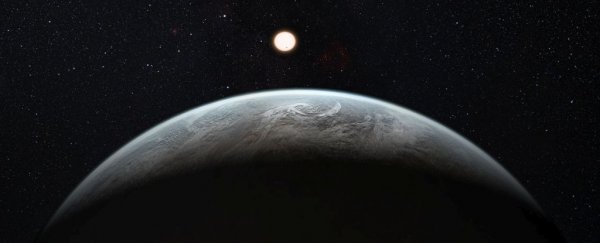Just over four light-years away, our Solar System's closest neighboring stars can be found. There's red dwarf Proxima Centauri, at a distance of 4.2 light-years; and, just a little farther, at 4.37 light-years, a binary system of Sun-like stars – Alpha Centauri AB.
We don't yet know if there are any Earth-like worlds orbiting the binary. Such exoplanets are just a little too tricky to detect with our current technology. But if there is one there, we now have a better idea of what it might be like, thanks to a study led by planetary scientist Haiyang Wang of ETH Zürich in Switzerland.
The international team studied the chemistry of the two stars – Rigil Kentaurus and Toliman – and used it to infer the chemical composition of a hypothetical rocky world in the habitable zone of the binary system.
"We present an analysis of planetary bulk composition, interiors, and (early) atmospheres for a model Earth-sized planet in the habitable zone of Alpha Centauri AB," the researchers write in their paper.
"The detailed analysis offers a new approach of investigation to what we may expect for Earth-sized planets in the habitable zones in the solar neighborhood."
These characteristics of rocky exoplanets are vital to understanding their long-term evolution and potential habitability. We know, based on observations of the rocky objects in the Solar System and other planetary systems, that the mineral composition of rocky worlds is reflected in that of their host stars.
Because Alpha Centauri AB is so close, we have a lot of information about its chemical composition, obtained from spectra. As different elements in the star absorb and re-emit light, they can generate dark (absorption) and bright (emission) features on the light spectrum that hits our telescopes. These features can be used to determine the chemical composition.
We know from spectral analyses that rock-forming elements, such as magnesium, silicon, and iron, are present in Rigil Kentaurus and Toliman, as well as volatiles that evaporate quickly, such as carbon and oxygen.
Our spectral analyses even reveal roughly how much of each element there is, useful for extrapolating hypothetical rocky worlds in the habitable zone – the 'temperate' distance from the star that is neither too hot nor too cold for liquid water to be present on the surface.
The researchers called their hypothetical world "α-Cen-Earth", and determined that it would likely have a mineral composition and structure very similar to Earth's. That includes a rocky mantle, with a water storage capacity similar to that of Earth, dominated by silicate minerals, but also containing a healthy proportion of carbon-bearing minerals such as diamond and graphite.
This exoplanet might also have a slightly larger iron core than Earth's, with less geological activity, and perhaps no plate tectonics, which could make it more similar to Venus. That could affect its potential habitability.
So far, so good. But it becomes a bit harder to infer the atmosphere of exoplanets based on stellar composition, since the relationship between the two is much less firm for airy volatiles.
However, Wang has spent the last few years developing and refining a quantitative model that connects the compositions of Sun-like stars to the compositions of their exoplanets, for both refractory and volatile elements.
This allowed the team to construct an atmosphere for α-Cen-Earth; interestingly, in the exoplanet's early years, it would have had an atmosphere very similar to that of early Earth, in the Archaeon eon in which life emerged. This historic atmosphere, according to the team's calculations, would have been dominated by methane, carbon dioxide, and water.
If such a world does exist, it could yield clues as to Earth's future. Alpha Centauri AB is around 1.5 to 2 billion years older than the Sun, which means any exoplanets hosted by Rigil Kentaurus and Toliman would likewise be older. And we're in a good position to discover such hypothetical worlds very soon.
Our exoplanet detection methods and technology are getting more sensitive – soon, astronomers will be able to detect many smaller exoplanets that are more distant from their stars (like Earth), and have eluded us so far.
Rigil Kentaurus and Toliman, from our perspective, will be growing more distant from each other in their orbit from this year. That separation, which will last until about 2035, will mean the light from the stars will be less likely to interfere with exoplanet observations.
Scientists have already made a tentative detection of a relatively small exoplanet, between 3.3 and 7 times the size of Earth, orbiting Rigil Kentaurus. We're looking forward to seeing what else might be hanging around some of the closest stars to Earth.
The research has been published in The Astrophysical Journal.
